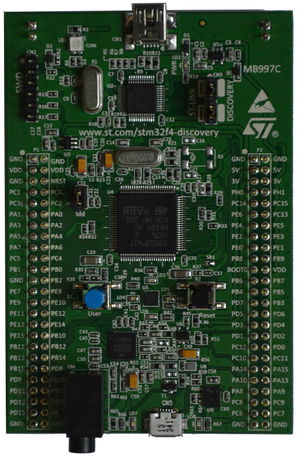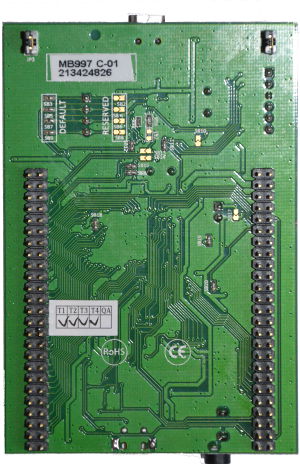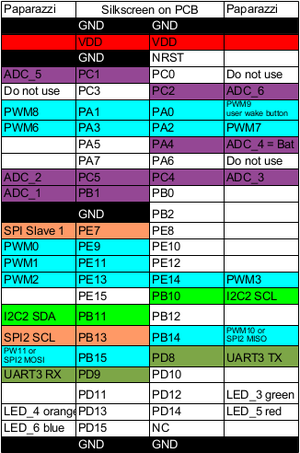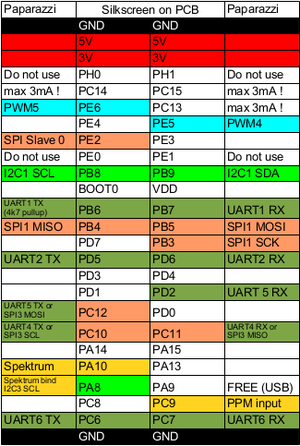Difference between revisions of "STM32F4 Discovery"
Jump to navigation
Jump to search
(→Pinout: updated pinout according to header file) |
|||
| Line 30: | Line 30: | ||
== Pinout == | == Pinout == | ||
[[Image:Stm32f4_discovery_left_bank.png|thumb|right|300px|left pin bank in relation to paparazzi]] | [[Image:Stm32f4_discovery_left_bank.png|thumb|right|300px|left pin bank in relation to paparazzi(not up to date!)]] | ||
[[Image:Stm32f4_discovery_right_bank.png|thumb|right|300px|right pin bank in relation to paparazzi]] | [[Image:Stm32f4_discovery_right_bank.png|thumb|right|300px|right pin bank in relation to paparazzi(not up to date!)]] | ||
The Discovery has a male 100 pin (2x25pin on both sides, also accessible on both sides of the pcb) pinout. | The Discovery has a male 100 pin (2x25pin on both sides, also accessible on both sides of the pcb) pinout. | ||
| Line 65: | Line 65: | ||
!width="7%"|''Pin #''!!width="10%"|''Name''!!width="10%"|''Type''!!''Description'' | !width="7%"|''Pin #''!!width="10%"|''Name''!!width="10%"|''Type''!!''Description'' | ||
|- | |- | ||
|PD5||UART2 TX||Out|| | |PD5||UART2 TX||Out||UART2 Serial Output | ||
|- | |- | ||
|PD6||UART2 RX||In|| | |PD6||UART2 RX||In||UART2 Serial Input, also used for Spektrum input | ||
|} | |} | ||
| Line 75: | Line 75: | ||
!width="7%"|''Pin #''!!width="10%"|''Name''!!width="10%"|''Type''!!''Description'' | !width="7%"|''Pin #''!!width="10%"|''Name''!!width="10%"|''Type''!!''Description'' | ||
|- | |- | ||
|PD8||UART3 TX||Out|| | |PD8||UART3 TX||Out||UART3 Serial Output | ||
|- | |- | ||
|PD9||UART3 RX||In|| | |PD9||UART3 RX||In||UART3 Serial Input | ||
|} | |} | ||
| Line 85: | Line 85: | ||
!width="7%"|''Pin #''!!width="10%"|''Name''!!width="10%"|''Type''!!''Description'' | !width="7%"|''Pin #''!!width="10%"|''Name''!!width="10%"|''Type''!!''Description'' | ||
|- | |- | ||
|PC10||UART4 TX||Out|| | |PC10||UART4 TX||Out||UART4 Serial Output | ||
|- | |- | ||
|PC11||UART4 RX||In|| | |PC11||UART4 RX||In||UART4 Serial Input | ||
|} | |} | ||
| Line 95: | Line 95: | ||
!width="7%"|''Pin #''!!width="10%"|''Name''!!width="10%"|''Type''!!''Description'' | !width="7%"|''Pin #''!!width="10%"|''Name''!!width="10%"|''Type''!!''Description'' | ||
|- | |- | ||
|PC12||UART5 TX||Out|| | |PC12||UART5 TX||Out||UART5 Serial Output | ||
|- | |- | ||
|PD2||UART5 RX||In|| | |PD2||UART5 RX||In||UART5 Serial Input | ||
|} | |} | ||
| Line 105: | Line 105: | ||
!width="7%"|''Pin #''!!width="10%"|''Name''!!width="10%"|''Type''!!''Description'' | !width="7%"|''Pin #''!!width="10%"|''Name''!!width="10%"|''Type''!!''Description'' | ||
|- | |- | ||
|PC6||UART6 TX||Out|| | |PC6||UART6 TX||Out||UART6 Serial Output | ||
|- | |- | ||
|PC7||UART6 RX||In|| | |PC7||UART6 RX||In||UART6 Serial Input | ||
|} | |} | ||
{|border="1" cellspacing="0" style="text-align:center" cellpadding="2%" width="60%" | |||
|+'''SPI1 for onboard LIS302''' | |||
!width="7%"|''Pin #''!!width="10%"|''Name''!!width="10%"|''Type''!!''Description'' | |||
|- | |||
|PA5||SPI1 SCK||I/O||SPI1 Serial clock | |||
|- | |||
|PA6||SPI1 MISO||I/O||SPI1 Master In Slave Out | |||
|- | |||
|PA7||SPI1 MOSI||I/O||SPI1 Master Out Slave In | |||
|- | |||
|PE2||SPI SS0||I/O||SPI1 Select Slave0 | |||
|} | |||
{|border="1" cellspacing="0" style="text-align:center" cellpadding="2%" width="60%" | {|border="1" cellspacing="0" style="text-align:center" cellpadding="2%" width="60%" | ||
| Line 120: | Line 133: | ||
|- | |- | ||
|PB5||SPI1 MOSI||I/O||SPI1 Master Out Slave In | |PB5||SPI1 MOSI||I/O||SPI1 Master Out Slave In | ||
|- | |||
|PE2||SPI SS0||I/O||SPI1 Select Slave0 | |||
|} | |} | ||
| Line 127: | Line 142: | ||
!width="7%"|''Pin #''!!width="10%"|''Name''!!width="10%"|''Type''!!''Description'' | !width="7%"|''Pin #''!!width="10%"|''Name''!!width="10%"|''Type''!!''Description'' | ||
|- | |- | ||
| | |PB13||SPI2 SCK||I/O||SPI2 Serial clock | ||
|- | |||
|PB14||SPI2 MISO||I/O||SPI2 Master In Slave Out | |||
|- | |- | ||
| | |PB15||SPI2 MOSI||I/O||SPI2 Master Out Slave In | ||
|- | |- | ||
| | |PE7||SPI SS1||I/O||SPI2 Select Slave1 | ||
|} | |} | ||
| Line 139: | Line 156: | ||
!width="7%"|''Pin #''!!width="10%"|''Name''!!width="10%"|''Type''!!''Description'' | !width="7%"|''Pin #''!!width="10%"|''Name''!!width="10%"|''Type''!!''Description'' | ||
|- | |- | ||
| | |PC10||SPI3 SCK||I/O||SPI3 Serial clock | ||
|- | |- | ||
| | |PC11||SPI3 MISO||I/O||SPI3 Master In Slave Out | ||
|- | |- | ||
| | |PC12||SPI3 MOSI||I/O||SPI3 Master Out Slave In | ||
|- | |- | ||
| | |PE3||SPI SS2||I/O||SPI3 Select Slave1 | ||
|} | |} | ||
| Line 194: | Line 203: | ||
|PB1||AUX1||I/O||ADC_1 | |PB1||AUX1||I/O||ADC_1 | ||
|- | |- | ||
| | |PC5||AUX2||I/O||ADC_2 | ||
|- | |- | ||
|PC4||AUX3||I/O||ADC_3 | |PC4||AUX3||I/O||ADC_3 | ||
|- | |- | ||
|PA4|| | |PA4||BAT||I/O||ADC_4, is used for BAT voltage | ||
|- | |||
|PC5||AUX5||I/O||ADC_5 | |||
|- | |||
|PC2||AUX6||I/O||ADC_6 | |||
|} | |} | ||
| Line 212: | Line 225: | ||
|PE13||PWM2||Out||Servo 3 | |PE13||PWM2||Out||Servo 3 | ||
|- | |- | ||
| | |PE14||PWM3||Out||Servo 4 | ||
|- | |- | ||
|PE5||PWM4||Out||Servo 5 | |PE5||PWM4||Out||Servo 5 | ||
Revision as of 07:54, 9 March 2014
This page is for the STM32F4 Discovery board with STM32F407VGT6, STM32F4 Disco is a familiar board with STM32F401VCT6, do not use this Files for the Disco board !
Overview
- STMicroelectronics STM32F4VGT6 Cortex M4 MCU, up to 168Mhz with floating point unit (FPU), 192 KB RAM, 1024 KB Flash
- on-board STLinkv2 with SWD header (capable of programming itself or an external MCU)
- ob-board power regulator for the MCU (3V or 5V Input)
- 1 x user push button
- 4(5) x LED (orange, green, red, blue, green)
- 6 x UART (UART1, UART2, UART3, UART4, UART5, UART6)
- 3 x SPI (SPI1, SPI2, SPI3)
- 2(3) x I2C (I2C1, I2C2, (I2C3))
- 1 x PPM input
- 4 x ADC input, which one is used for bat voltage
- 97 x 66 mm PCB
- 4 x status LED (USB red, USB green, power, USB OTG green, USB OTG red)
- LIS302DL MEMS 3 axis accelerometer on SPI1
Pinout
The Discovery has a male 100 pin (2x25pin on both sides, also accessible on both sides of the pcb) pinout.
| Pin # | Name | Type | Description | Color |
|---|---|---|---|---|
| PD13 | LED_3 | I/O | above LIS302DL | Orange |
| PD12 | LED_4 | I/O | left of LIS302DL | Green |
| PD14 | LED_5 | I/O | right of LIS302DL | Red |
| PD15 | LED_6 | I/O | below LIS302DL | Blue |
| PA9 | LED_9 | I/O | same as USB power (VBUS), needs to be enabled in stm32f4_discovery.h | Green |
| Pin # | Name | Type | Description |
|---|---|---|---|
| PB6 | UART1 TX | Out | UART1 Serial Output |
| PB7 | UART1 RX | In | UART1 Serial Input |
| Pin # | Name | Type | Description |
|---|---|---|---|
| PD5 | UART2 TX | Out | UART2 Serial Output |
| PD6 | UART2 RX | In | UART2 Serial Input, also used for Spektrum input |
| Pin # | Name | Type | Description |
|---|---|---|---|
| PD8 | UART3 TX | Out | UART3 Serial Output |
| PD9 | UART3 RX | In | UART3 Serial Input |
| Pin # | Name | Type | Description |
|---|---|---|---|
| PC10 | UART4 TX | Out | UART4 Serial Output |
| PC11 | UART4 RX | In | UART4 Serial Input |
| Pin # | Name | Type | Description |
|---|---|---|---|
| PC12 | UART5 TX | Out | UART5 Serial Output |
| PD2 | UART5 RX | In | UART5 Serial Input |
| Pin # | Name | Type | Description |
|---|---|---|---|
| PC6 | UART6 TX | Out | UART6 Serial Output |
| PC7 | UART6 RX | In | UART6 Serial Input |
| Pin # | Name | Type | Description |
|---|---|---|---|
| PA5 | SPI1 SCK | I/O | SPI1 Serial clock |
| PA6 | SPI1 MISO | I/O | SPI1 Master In Slave Out |
| PA7 | SPI1 MOSI | I/O | SPI1 Master Out Slave In |
| PE2 | SPI SS0 | I/O | SPI1 Select Slave0 |
| Pin # | Name | Type | Description |
|---|---|---|---|
| PB3 | SPI1 SCK | I/O | SPI1 Serial clock |
| PB4 | SPI1 MISO | I/O | SPI1 Master In Slave Out |
| PB5 | SPI1 MOSI | I/O | SPI1 Master Out Slave In |
| PE2 | SPI SS0 | I/O | SPI1 Select Slave0 |
| Pin # | Name | Type | Description |
|---|---|---|---|
| PB13 | SPI2 SCK | I/O | SPI2 Serial clock |
| PB14 | SPI2 MISO | I/O | SPI2 Master In Slave Out |
| PB15 | SPI2 MOSI | I/O | SPI2 Master Out Slave In |
| PE7 | SPI SS1 | I/O | SPI2 Select Slave1 |
| Pin # | Name | Type | Description |
|---|---|---|---|
| PC10 | SPI3 SCK | I/O | SPI3 Serial clock |
| PC11 | SPI3 MISO | I/O | SPI3 Master In Slave Out |
| PC12 | SPI3 MOSI | I/O | SPI3 Master Out Slave In |
| PE3 | SPI SS2 | I/O | SPI3 Select Slave1 |
| Pin # | Name | Type | Description |
|---|---|---|---|
| PB8 | I2C1 SCL | I/O | I2C1 Serial Clock |
| PB9 | I2C1 SDA | I/O | I2C1 Serial Data |
| Pin # | Name | Type | Description |
|---|---|---|---|
| PB10 | I2C2 SCL | I/O | I2C2 Serial Clock |
| PB11 | I2C2 SDA | I/O | I2C2 Serial Data |
| Pin # | Name | Type | Description |
|---|---|---|---|
| PA8 | I2C3 SCL | I/O | I2C3 Serial Clock |
| PC9 | I2C3 SDA | I/O | I2C3 Serial Data |
Note: is disabled in stm32f4discovery.h, PA8 is used as Spektrum bind pin, PC9 is used as PPM input
| Pin # | Name | Type | Description |
|---|---|---|---|
| PB1 | AUX1 | I/O | ADC_1 |
| PC5 | AUX2 | I/O | ADC_2 |
| PC4 | AUX3 | I/O | ADC_3 |
| PA4 | BAT | I/O | ADC_4, is used for BAT voltage |
| PC5 | AUX5 | I/O | ADC_5 |
| PC2 | AUX6 | I/O | ADC_6 |
| Pin # | Name | Type | Description |
|---|---|---|---|
| PE9 | PWM0 | Out | Servo 1 |
| PE11 | PWM1 | Out | Servo 2 |
| PE13 | PWM2 | Out | Servo 3 |
| PE14 | PWM3 | Out | Servo 4 |
| PE5 | PWM4 | Out | Servo 5 |
| PE6 | PWM5 | Out | Servo 6 |
| PA3 | PWM6 | Out | Servo 7 |
| PA2 | PWM7 | Out | Servo 8 |
| PA1 | PWM8 | Out | Servo 9 |
| PA0 | PWM9 | Out | Servo 10 |
| PB14 | PWM10 | Out | Servo 11, Can not be used if SPI2 is active |
| PB15 | PWM11 | Out | Servo 12, Can not be used if SPI2 is active |
| Pin # | Name | Type | Description |
|---|---|---|---|
| PC9 | PPM | In | PPM input |
Jumper
| Pin # | Name | Type | Description |
|---|---|---|---|
| JP1 | JP1 | Switch | MCU Current can be measured here |
| CN3 | CN3 | Switch | closed: STLinkV2 is connected to onboard MCU, open: is not connectec to onboard, only external header |
| Pin # | Name | Type | Description |
|---|---|---|---|
| SB17 | SB17 | Switch | Bypass for JP1, close this for security ! (if JP1 gets loose) |
Firmware Flashing
FLASH_MODE=STLINK is set as default
STM32F4 Discovery can mainly be programmed in two different ways:
STLINK
- with onboard STLinkV2 over SWD
- required hardware: usb to mini USB cable
- required software: st_flash and st_util from Texane
- more information: STLink page
DFU-UTIL
- with the MCU native (embedded in rom) DFU USB bootloader over the micro USB AB connector
- required hardware: USB to micro and USB to mini usb cable
- required external software: dfu-util
- push MCU in DFU mode: connect mini and micro USB to PC, connect pin BOOT0 with 3V (if it doesnt work also BOOT1 (PB2) with GND), press reset button(LED LD7 should light up now), disconnect BOOT0 to 3V
- more information: DFU page



